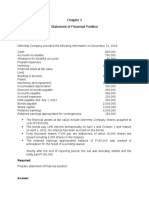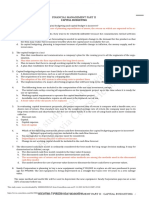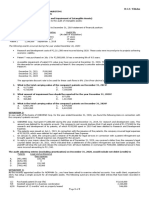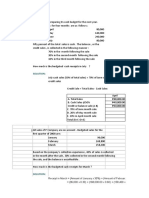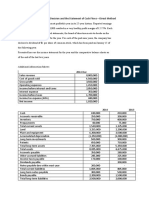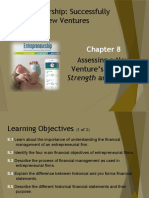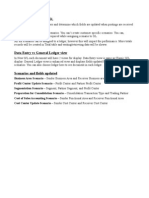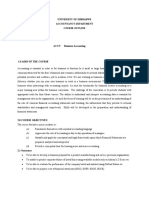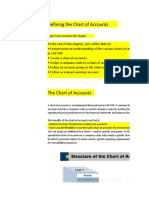Garrison FSA Solman PDF
Uploaded by
Geraldo MejillanoGarrison FSA Solman PDF
Uploaded by
Geraldo MejillanoGarrison - Chapter 16 “How Well Am I Doing?
”--Financial Statement
Analysis
Essay Questions
173. Espinola Corporation's most recent balance sheet and income statement appear below:
Statement of Financial Position
December 31, Year 2 and Year 1
(in thousands of dollars)
Year 2 Year 1
Assets
Current assets:
Cash ................................................................... $ 320 $ 180
Accounts receivable .......................................... 220 240
Inventory ........................................................... 140 130
Prepaid expenses ............................................... 20 20
Total current assets ............................................... 700 570
Plant and equipment, net ...................................... 860 920
Total assets ........................................................... $1,560 $1,490
Liabilities and Stockholders’ Equity
Current liabilities:
Accounts payable .............................................. $ 200 $ 170
Accrued liabilities ............................................. 80 80
Notes payable, short term .................................. 40 40
Total current liabilities ......................................... 320 290
Bonds payable ...................................................... 210 220
Total liabilities...................................................... 530 510
Stockholders’ equity:
Preferred stock, $100 par value, 5% ................. 100 100
Common stock, $1 par value ............................. 100 100
Additional paid-in capital–common stock ........ 150 150
Retained earnings .............................................. 680 630
Total stockholders’ equity .................................... 1,030 980
Total liabilities & stockholders’ equity ................ $1,560 $1,490
Garrison/Noreen/Brewer, Managerial Accounting, Twelfth Edition 16-5
Income Statement
For the Year Ended December 31, Year 2
(in thousands of dollars)
Sales (all on account) ........................................... $1,220
Cost of goods sold ................................................ 790
Gross margin ........................................................ 430
Selling and administrative expense ...................... 268
Net operating income ........................................... 162
Interest expense .................................................... 26
Net income before taxes ....................................... 136
Income taxes (30%) .............................................. 41
Net income ........................................................... $ 95
Dividends on common stock during Year 2 totaled $40 thousand. Dividends on
preferred stock totaled $5 thousand. The market price of common stock at the end of
Year 2 was $12.87 per share.
Required:
Compute the following for Year 2:
a. Gross margin percentage.
b. Earnings per share (of common stock).
c. Price-earnings ratio.
d. Dividend payout ratio.
e. Dividend yield ratio.
f. Return on total assets.
g. Return on common stockholders' equity.
h. Book value per share.
i. Working capital.
j. Current ratio.
k. Acid-test ratio.
l. Accounts receivable turnover.
m. Average collection period.
n. Inventory turnover.
o. Average sale period.
p. Times interest earned.
q. Debt-to-equity ratio.
16-6 Garrison/Noreen/Brewer, Managerial Accounting, Twelfth Edition
Ans:
a. Gross margin percentage = Gross margin ÷ Sales = $430 ÷ $1,220 = 35.2%
b. Earnings per share = (Net Income − Preferred Dividends)
÷ Average number of common shares outstanding*
= ($95 − $5) ÷ (100 shares + 100 shares)/2 = $0.90 per share
*Number of common shares outstanding
= Common stock ÷ Par value = $100 ÷ $1 per share = 100 shares
c. Price-earnings ratio = Market price per share ÷ Earnings per share (see above)
= $12.87 ÷ $0.90 = 14.3
d. Dividend payout ratio = Dividends per share* ÷ Earnings per share (see
above)
= $0.40 ÷ $0.90 = 44.4%
*Dividends per share = Common dividends ÷ Common shares (see above)
= $40 ÷ 100 shares = $0.40 per share
e. Dividend yield ratio = Dividends per share (see above) ÷ Market price per
share
= $0.40 ÷ $12.87 = 3.11%
f. Return on total assets = Adjusted net income* ÷ Average total assets**
= $113.2 ÷ $1,525 = 7.42%
*Adjusted net income
= Net income + [Interest expense × (1−Tax rate)]
= $95 + 26 × (1-0.30) = $113.2
**Average total assets = ($1,560 + $1,490) ÷ 2 = $1,525
g. Return on common stockholders' equity = (Net income − Preferred dividends)
÷ Average common stockholders' equity*
= ($95 − $5) ÷ $905 = 9.94%
*Average common stockholders' equity = ($930 + $880) ÷ 2 = $905
h. Book value per share = Common stockholders' equity ÷ Number of common
shares outstanding* = $930 ÷ 100 shares = $9.30 per share
*Number of common shares outstanding = Common stock ÷ Par value
= $100 ÷ $1 per share = 100 shares
i. Working capital = Current assets − Current liabilities = $700 - $320 = $380
Garrison/Noreen/Brewer, Managerial Accounting, Twelfth Edition 16-7
j. Current ratio = Current assets ÷ Current liabilities = $700 ÷ $320 = 2.19
k. Acid-test ratio = Quick assets* ÷ Current liabilities = $540 ÷ $320 = 1.69
*Quick assets = Cash + Marketable securities + Accounts receivable + Short-
term notes receivable = $320 + $0 + $220 = $540
l. Accounts receivable turnover = Sales on account ÷ Average accounts
receivable* = $1,220 ÷ $230 = 5.30
*Average accounts receivable = ($220 + $240) ÷ 2 = $230
m. Average collection period = 365 days ÷ Accounts receivable turnover (see
above) = 365 days ÷ 5.30 = 68.9 days
n. Inventory turnover = Cost of goods sold ÷ Average inventory*
= $790 ÷ $135 = 5.85
*Average inventory = ($140 + $130) ÷ 2 = $135
o. Average sale period = 365 days ÷ Inventory turnover (see above)
= 365 days ÷ 5.85 = 62.4 days
p. Times interest earned = Net operating income ÷ Interest expense
= $162 ÷ $26 = 6.23
q. Debt-to-equity ratio = Liabilities ÷ Stockholders' equity
= $530 ÷ $1,030 = 0.51
AACSB: Analytic AICPA BB: Critical Thinking AICPA FN: Reporting
LO: 1,2,3,4 Level: Medium
16-8 Garrison/Noreen/Brewer, Managerial Accounting, Twelfth Edition
174. Slaubaugh Corporation's most recent balance sheet and income statement appear
below:
Statement of Financial Position
December 31, Year 2 and Year 1
(in thousands of dollars)
Year 2 Year 1
Assets
Current assets:
Cash .................................................................... $ 100 $ 140
Accounts receivable ........................................... 160 180
Inventory ............................................................ 210 190
Prepaid expenses ................................................ 40 50
Total current assets ................................................ 510 560
Plant and equipment, net ....................................... 860 820
Total assets ............................................................ $1,370 $1,380
Liabilities and Stockholders’ Equity
Current liabilities:
Accounts payable ............................................... $ 160 $ 180
Accrued liabilities .............................................. 80 80
Notes payable, short term ................................... 80 80
Total current liabilities .......................................... 320 340
Bonds payable ....................................................... 70 100
Total liabilities....................................................... 390 440
Stockholders’ equity:
Preferred stock, $100 par value, 10% ................ 200 200
Common stock, $1 par value .............................. 200 200
Additional paid-in capital–common stock ......... 130 130
Retained earnings ............................................... 450 410
Total stockholders’ equity ..................................... 980 940
Total liabilities & stockholders’ equity ................. $1,370 $1,380
Garrison/Noreen/Brewer, Managerial Accounting, Twelfth Edition 16-9
Income Statement
For the Year Ended December 31, Year 2
(in thousands of dollars)
Sales (all on account) ............................................ $1,350
Cost of goods sold ................................................. 820
Gross margin ......................................................... 530
Selling and administrative expense ....................... 399
131
Net operating income ............................................
Interest expense ..................................................... 17
Net income before taxes ........................................ 114
Income taxes (30%) ............................................... 34
Net income ............................................................ $ 80
Dividends on common stock during Year 2 totaled $20 thousand. Dividends on
preferred stock totaled $20 thousand. The market price of common stock at the end of
Year 2 was $2.88 per share.
Required:
Compute the following for Year 2:
a. Gross margin percentage.
b. Earnings per share (of common stock).
c. Price-earnings ratio.
d. Dividend payout ratio.
e. Dividend yield ratio.
f. Return on total assets.
g. Return on common stockholders' equity.
h. Book value per share.
Ans:
a. Gross margin percentage = Gross margin ÷ Sales = $530 ÷ $1,350 = 39.3%
b. Earnings per share = (Net Income - Preferred Dividends)
÷ Average number of common shares outstanding*
= ($80 - $20) ÷ (200 shares + 200 shares)/2 = $0.30 per share
*Number of common shares outstanding = Common stock ÷ Par value = $200 ÷
$1 per share = 200 shares
c. Price-earnings ratio = Market price per share ÷ Earnings per share (see above)
= $2.88 ÷ $0.30 = 9.6
16-10 Garrison/Noreen/Brewer, Managerial Accounting, Twelfth Edition
d. Dividend payout ratio = Dividends per share* ÷ Earnings per share (see
above)
= $0.10 ÷ $0.30 = 33.3%
*Dividends per share = Common dividends ÷ Common shares (see above)
= $20 ÷ 200 shares = $0.10 per share
e. Dividend yield ratio = Dividends per share (see above) ÷ Market price per
share
= $0.10 ÷ $2.88 = 3.47%
f. Return on total assets = Adjusted net income* ÷ Average total assets**
= $91.9 ÷ $1,375 = 6.68%
*Adjusted net income = Net income + [Interest expense × (1−Tax rate)]
= $80 + 17 × (1−0.30) = $91.9
**Average total assets = ($1,370 + $1,380) ÷ 2 = $1,375
g. Return on common stockholders' equity = (Net income − Preferred dividends)
÷ Average common stockholders' equity*
= ($80 − $20) ÷ $760 = 7.89%
*Average common stockholders' equity = ($780 + $740) ÷ 2 = $760
h. Book value per share = Common stockholders' equity
÷ Number of common shares outstanding*
= $780 ÷ 200 shares = $3.90 per share
*Number of common shares outstanding = Common stock ÷ Par value
= $200 ÷ $1 per share = 200 shares
AACSB: Analytic AICPA BB: Critical Thinking AICPA FN: Reporting
LO: 1,2 Level: Medium
Garrison/Noreen/Brewer, Managerial Accounting, Twelfth Edition 16-11
175. Philo Corporation's most recent income statement appears below:
Sales (all on account) ................................ $561,000
Cost of goods sold ..................................... 325,000
Gross margin ............................................. 236,000
Selling and administrative expense ........... 106,000
Net operating income ................................ 130,000
Interest expense ......................................... 35,000
Net income before taxes ............................ 95,000
Income taxes .............................................. 30,000
Net income ................................................ $ 65,000
Required:
Compute the gross margin percentage.
Ans:
Gross margin percentage = Gross margin ÷ Sales = $236,000 ÷ $561,000 = 42.1%
AACSB: Analytic AICPA BB: Critical Thinking AICPA FN: Reporting
LO: 1 Level: Easy
16-12 Garrison/Noreen/Brewer, Managerial Accounting, Twelfth Edition
176. Financial statements for Pratt Company appear below:
Pratt Company
Statement of Financial Position
December 31, Year 2 and Year 1
(dollars in thousands)
Year 2 Year 1
Current assets:
Cash and marketable securities .......................... $ 140 $ 140
Accounts receivable, net .................................... 190 180
Inventory ............................................................ 150 150
Prepaid expenses ................................................ 70 70
Total current assets ................................................ 550 540
Noncurrent assets:
Plant & equipment, net ....................................... 1,490 1,420
Total assets ............................................................ $2,040 $1,960
Current liabilities:
Accounts payable ............................................... $ 160 $ 160
Accrued liabilities .............................................. 50 60
Notes payable, short term ................................... 230 250
Total current liabilities .......................................... 440 470
Noncurrent liabilities:
Bonds payable .................................................... 300 300
Total liabilities....................................................... 740 770
Stockholders’ equity:
Preferred stock, $5 par, 10% .............................. 120 120
Common stock, $5 par ....................................... 180 180
Additional paid-in capital–common stock ......... 210 210
Retained earnings ............................................... 790 680
Total stockholders’ equity ..................................... 1,300 1,190
Total liabilities & stockholders’ equity ................. $2,040 $1,960
Garrison/Noreen/Brewer, Managerial Accounting, Twelfth Edition 16-13
Pratt Company
Income Statement
For the Year Ended December 31, Year 2
(dollars in thousands)
Sales (all on account) ............................................ $2,000
Cost of goods sold ................................................. 1,400
Gross margin ......................................................... 600
Selling and administrative expense ....................... 240
Net operating income ............................................ 360
Interest expense ..................................................... 30
Net income before taxes ........................................ 330
Income taxes (30%) ............................................... 99
Net income ............................................................ $ 231
Dividends during Year 2 totaled $121 thousand, of which $12 thousand were preferred
dividends. The market price of a share of common stock on December 31, Year 2 was
$80.
Required:
Compute the following for Year 2:
a. Earnings per share of common stock.
b. Price-earnings ratio.
c. Dividend payout ratio.
d. Dividend yield ratio.
e. Return on total assets.
f. Return on common stockholders' equity.
g. Book value per share.
h. Working capital.
i. Current ratio.
j. Acid-test ratio.
k. Accounts receivable turnover.
l. Average collection period.
m. Inventory turnover.
n. Average sale period.
o. Times interest earned.
p. Debt-to-equity ratio.
16-14 Garrison/Noreen/Brewer, Managerial Accounting, Twelfth Edition
Ans:
a. Earnings per share = (Net Income − Preferred Dividends) ÷
Average number of common shares outstanding*
= ($231 − $12) ÷ 36 = $6.08
*Number of common shares outstanding = Common stock ÷ Par value
= $180 ÷ $5 = 36
b. Price-earnings ratio = Market price per share ÷ Earnings per share (see above)
= $80 ÷ $6.08 = 13.2
c. Dividend payout ratio = Dividends per share* ÷ Earnings per share (see
above)
= $3.03 ÷ $6.08 = 49.8%
*Dividends per share = Common dividends ÷ Common shares**
= $109 ÷ 36 = $3.03
**See above
d. Dividend yield ratio = Dividends per share* ÷ Market price per share
= $3.03 ÷ $80.00 = 3.78% *See above
e. Return on total assets = Adjusted net income* ÷ Average total assets**
= $252 ÷ $2,000 = 12.60%
*Adjusted net income = Net income + [Interest expense × (1−Tax rate)]
= $231 + 30 × (1 − 0.30) = $252
**Average total assets = ($2,040 + $1,960) ÷ 2 = $2,000
f. Return on common stockholders' equity = (Net income − Preferred dividends)
÷
Average common stockholders' equity* = ($231 − $12) ÷ $1,125 = 19.47%
*Average common stockholders' equity = ($1,180 + $1,070) ÷ 2 = $1,125
g. Book value per share = Common stockholders' equity ÷
Number of common shares outstanding* = $1,180 ÷ 36 = $32.78
*Number of common shares outstanding = Common stock ÷ Par value
= $180 ÷ $5 = 36
Garrison/Noreen/Brewer, Managerial Accounting, Twelfth Edition 16-15
h. Working capital = Current assets − Current liabilities = $550 − $440 = $110
i. Current ratio = Current assets ÷ Current liabilities = $550 ÷ $440 = 1.25
j. Acid-test ratio = Quick assets* ÷ Current liabilities = $330 ÷ $440 = 0.75
*Quick assets = Cash + Marketable securities + Accounts receivable + Short-
term notes receivable = $140 + $190 = $330
k. Accounts receivable turnover = Sales on account ÷ Average accounts
receivable* = $2,000 ÷ $185 = 10.81
*Average accounts receivable = ($190 + $180) ÷ 2 = $185
l. Average collection period = 365 days ÷ Accounts receivable turnover*
= 365 ÷ 10.81 = 33.8 days *See above
m. Inventory turnover = Cost of goods sold ÷ Average inventory* = $1,400 ÷
$150 = 9.33
*Average inventory = ($150 + $150) ÷ 2 = $150
n. Average sale period = 365 days ÷ Inventory turnover* = 365 ÷9.33
= 39.1 days *See above
o. Times interest earned = Net operating income ÷ Interest expense
= $360 ÷ $30 = 12.00
p. Debt-to-equity ratio = Liabilities ÷ Stockholders' equity = $740 ÷ $1,300
= 0.57
AACSB: Analytic AICPA BB: Critical Thinking AICPA FN: Reporting
LO: 2,3,4 Level: Medium
16-16 Garrison/Noreen/Brewer, Managerial Accounting, Twelfth Edition
177. Financial statements for Qadri Company appear below:
Qadri Company
Statement of Financial Position
December 31, Year 2 and Year 1
(dollars in thousands)
Year 2 Year 1
Current assets:
Cash and marketable securities .......................... $ 120 $ 100
Accounts receivable, net .................................... 130 120
Inventory ............................................................ 160 180
Prepaid expenses ................................................ 50 50
Total current assets ................................................ 460 450
Noncurrent assets:
Plant & equipment, net ....................................... 1,730 1,730
Total assets ............................................................ $2,190 $2,180
Current liabilities:
Accounts payable ............................................... $ 50 $ 100
Accrued liabilities .............................................. 60 50
Notes payable, short term ................................... 160 200
Total current liabilities .......................................... 270 350
Noncurrent liabilities:
Bonds payable .................................................... 280 300
Total liabilities....................................................... 550 650
Stockholders’ equity:
Preferred stock, $10 par, 5% .............................. 120 120
Common stock, $10 par ..................................... 220 220
Additional paid-in capital–common stock ......... 110 110
Retained earnings ............................................... 1,190 1,080
Total stockholders’ equity ..................................... 1,640 1,530
Total liabilities & stockholders’ equity ................. $2,190 $2,180
Garrison/Noreen/Brewer, Managerial Accounting, Twelfth Edition 16-17
Qadri Company
Income Statement
For the Year Ended December 31, Year 2
(dollars in thousands)
Sales (all on account) ............................................ $2,300
Cost of goods sold ................................................. 1,610
Gross margin ......................................................... 690
Selling and administrative expense ....................... 270
Net operating income ............................................ 420
Interest expense ..................................................... 30
Net income before taxes ........................................ 390
Income taxes (30%) ............................................... 117
Net income ............................................................ $ 273
Dividends during Year 2 totaled $163 thousand, of which $6 thousand were preferred
dividends. The market price of a share of common stock on December 31, Year 2 was
$150.
Required:
Compute the following for Year 2:
a. Earnings per share of common stock.
b. Price-earnings ratio.
c. Dividend yield ratio.
d. Return on total assets.
e. Return on common stockholders' equity.
f. Book value per share.
Ans:
a. Earnings per share = (Net Income − Preferred Dividends) ÷
Average number of common shares outstanding* = ($273 − $6) ÷ 22 = $12.14
*Number of common shares outstanding = Common stock ÷ Par value
= $220 ÷ $10 = 22
b. Price-earnings ratio = Market price per share ÷ Earnings per share (see above)
= $150 ÷ $12.14 = 12.4
16-18 Garrison/Noreen/Brewer, Managerial Accounting, Twelfth Edition
c. Dividend yield ratio = Dividends per share* ÷ Market price per share
= $7.14 ÷ $150.00 = 4.76%
*Dividends per share = Common dividends ÷ Common shares**
= $157 ÷ 22 = $7.14
**See above
d. Return on total assets = Adjusted net income* ÷ Average total assets**
= $294 ÷ $2,185 = 13.46%
*Adjusted net income = Net income + [Interest expense × (1−Tax rate)]
= $273 + 30 × (1 − 0.30) = $294
**Average total assets = ($2,190 + $2,180) ÷ 2 = $2,185
e. Return on common stockholders' equity = (Net income − Preferred dividends)
÷
Average common stockholders' equity* = ($273 − $6) ÷ $1,465 = 18.23%
*Average common stockholders' equity = ($1,520 + $1,410) ÷ 2 = $1,465
f. Book value per share = Common stockholders' equity ÷ Number of common
shares outstanding* = $1,520 ÷ 22 = $69.09
*Number of common shares outstanding = Common stock ÷ Par value
= $220 ÷ $10 = 22
AACSB: Analytic AICPA BB: Critical Thinking AICPA FN: Reporting
LO: 2 Level: Medium
Garrison/Noreen/Brewer, Managerial Accounting, Twelfth Edition 16-19
178. Maranville Corporation's most recent balance sheet and income statement appear
below:
Statement of Financial Position
December 31, Year 2 and Year 1
(in thousands of dollars)
Year 2 Year 1
Assets
Current assets:
Cash .................................................................... $ 170 $ 180
Accounts receivable ........................................... 160 180
Inventory ............................................................ 170 160
Prepaid expenses ................................................ 70 60
Total current assets ................................................ 570 580
Plant and equipment, net ....................................... 840 830
Total assets ............................................................ $1,410 $1,410
Liabilities and Stockholders’ Equity
Current liabilities:
Accounts payable ............................................... $ 150 $ 160
Accrued liabilities .............................................. 40 40
Notes payable, short term ................................... 50 50
Total current liabilities .......................................... 240 250
Bonds payable ....................................................... 90 100
Total liabilities....................................................... 330 350
Stockholders’ equity:
Preferred stock, $100 par value, 10% ................ 200 200
Common stock, $2 par value .............................. 400 400
Additional paid-in capital–common stock ......... 140 140
Retained earnings ............................................... 340 320
Total stockholders’ equity ..................................... 1,080 1,060
Total liabilities & stockholders’ equity ................. $1,410 $1,410
16-20 Garrison/Noreen/Brewer, Managerial Accounting, Twelfth Edition
Income Statement
For the Year Ended December 31, Year 2
(in thousands of dollars)
Sales (all on account) ............................................ $1,410
Cost of goods sold ................................................. 860
Gross margin ......................................................... 550
Selling and administrative expense ....................... 449
Net operating income ............................................ 101
Interest expense ..................................................... 15
Net income before taxes ........................................ 86
Income taxes (30%) ............................................... 26
Net income ............................................................ $ 60
Dividends on common stock during Year 2 totaled $20 thousand. Dividends on
preferred stock totaled $20 thousand. The market price of common stock at the end of
Year 2 was $2.36 per share.
Required:
Compute the following for Year 2:
a. Earnings per share (of common stock).
b. Price-earnings ratio.
c. Dividend payout ratio.
d. Dividend yield ratio.
e. Return on total assets.
f. Return on common stockholders' equity.
g. Book value per share.
Ans:
a. Earnings per share = (Net Income − Preferred Dividends)
÷ Average number of common shares outstanding*
= ($60 - $20) ÷ (200 shares + 200 shares)/2 = $0.20 per share
*Number of common shares outstanding = Common stock ÷ Par value
= $400 ÷ $2 per share = 200 shares
b. Price-earnings ratio = Market price per share ÷ Earnings per share (see above)
= $2.36 ÷ $0.20 = 11.8
Garrison/Noreen/Brewer, Managerial Accounting, Twelfth Edition 16-21
c. Dividend payout ratio = Dividends per share* ÷ Earnings per share (see
above)
= $0.10 ÷ $0.20 = 50.0%
*Dividends per share = Common dividends ÷ Common shares (see above)
= $20 ÷ 200 shares = $0.10 per share
d. Dividend yield ratio = Dividends per share (see above) ÷ Market price per
share = $0.10 ÷ $2.36 = 4.24%
e. Return on total assets = Adjusted net income* ÷ Average total assets**
= $70.5 ÷ $1,410 = 5.00%
*Adjusted net income
= Net income + [Interest expense × (1−Tax rate)]
= $60 + 15 × (1 − 0.30) = $70.5
**Average total assets = ($1,410 + $1,410) ÷ 2 = $1,410
f. Return on common stockholders' equity
= (Net income − Preferred dividends) ÷ Average common stockholders' equity*
= ($60 − $20) ÷ $870 = 4.60%
*Average common stockholders' equity = ($880 + $860) ÷ 2 = $870
g. Book value per share = Common stockholders' equity
÷ Number of common shares outstanding* = $880 ÷ 200 shares = $4.40 per
share
*Number of common shares outstanding = Common stock ÷ Par value
= $400 ÷ $2 per share = 200 shares
AACSB: Analytic AICPA BB: Critical Thinking AICPA FN: Reporting
LO: 2 Level: Medium
16-22 Garrison/Noreen/Brewer, Managerial Accounting, Twelfth Edition
179. Isidro Corporation has provided the following financial data (in thousands of dollars):
Year 2 Year 1
Total assets ............................................................ $1,520 $1,490
Stockholders’ equity:
Preferred stock, $100 par value, 5% .................. $200 $200
Common stock, $2 par value .............................. $400 $400
Additional paid-in capital–common stock ......... $160 $160
Retained earnings ............................................... $380 $320
Net income for Year 2 was $110 thousand. Interest expense was $21 thousand. The
tax rate was 30%. Dividends on common stock during Year 2 totaled $40 thousand.
Dividends on preferred stock totaled $10 thousand. The market price of common stock
at the end of Year 2 was $9.15 per share.
Required:
Compute the following for Year 2:
a. Earnings per share (of common stock).
b. Price-earnings ratio.
c. Dividend payout ratio.
d. Dividend yield ratio.
e. Return on total assets.
f. Return on common stockholders' equity.
g. Book value per share.
Ans:
a. Earnings per share = (Net Income − Preferred Dividends)
÷ Average number of common shares outstanding*
= ($110 − $10) ÷ (200 shares + 200 shares)/2 = $0.50 per share
*Number of common shares outstanding = Common stock ÷ Par value
= $400 ÷ $2 per share = 200 shares
b. Price-earnings ratio = Market price per share ÷ Earnings per share (see above)
= $9.15 ÷ $0.50 = 18.3
c. Dividend payout ratio = Dividends per share* ÷ Earnings per share (see
above)
= $0.20 ÷ $0.50 = 40.0%
*Dividends per share = Common dividends ÷ Common shares (see above)
= $40 ÷ 200 shares = $0.20 per share
Garrison/Noreen/Brewer, Managerial Accounting, Twelfth Edition 16-23
d. Dividend yield ratio = Dividends per share (see above) ÷ Market price per
share = $0.20 ÷ $9.15 = 2.19%
e. Return on total assets = Adjusted net income* ÷ Average total assets**
= $124.7 ÷ $1,505 = 8.29%
*Adjusted net income = Net income + [Interest expense × (1−Tax rate)]
= $110 + 21 × (1 − 0.30) = $124.7
**Average total assets = ($1,520 + $1,490) ÷ 2 = $1,505
f. Return on common stockholders' equity = (Net income − Preferred dividends)
÷ Average common stockholders' equity* = ($110 − $10) ÷ $910 = 10.99%
*Average common stockholders' equity = ($940 + $880) ÷ 2 = $910
g. Book value per share = Common stockholders' equity
÷ Number of common shares outstanding*
= $940 ÷ 200 shares = $4.70 per share
*Number of common shares outstanding = Common stock ÷ Par value
= $400 ÷ $2 per share = 200 shares
AACSB: Analytic AICPA BB: Critical Thinking AICPA FN: Reporting
LO: 2 Level: Easy
180. Mikolajczyk Corporation's net income for the most recent year was $1,379,000. A
total of 100,000 shares of common stock and 200,000 shares of preferred stock were
outstanding throughout the year. Dividends on common stock were $1.15 per share
and dividends on preferred stock were $1.30 per share.
Required:
Compute the earnings per share of common stock. Show your work!
Ans:
Earnings per share = (Net Income − Preferred Dividends)
÷ Average number of common shares outstanding
= ($1,379,000 − $260,000) ÷ 100,000 shares = $11.19 per share
AACSB: Analytic AICPA BB: Critical Thinking AICPA FN: Reporting
LO: 2 Level: Easy
16-24 Garrison/Noreen/Brewer, Managerial Accounting, Twelfth Edition
181. Hoa Corporation's net income last year was $7,460,000. The dividend on common
stock was $8.40 per share and the dividend on preferred stock was $4.30 per share.
The market price of common stock at the end of the year was $78.90 per share.
Throughout the year, 500,000 shares of common stock and 100,000 shares of preferred
stock were outstanding.
Required:
Compute the price-earnings ratio. Show your work!
Ans:
Price-earnings ratio = Market price per share ÷ Earnings per share*
= $78.90 ÷ $14.06 = 5.61
*Earnings per share
= (Net Income - Preferred Dividends) ÷ Average number of common shares
outstanding = ($7,460,000 - $430,000) ÷ 500,000 shares = $14.06 per share
AACSB: Analytic AICPA BB: Critical Thinking AICPA FN: Reporting
LO: 2 Level: Easy
182. Dupas Corporation's net income last year was $7,330,000. The dividend on common
stock was $12.70 per share and the dividend on preferred stock was $1.70 per share.
The market price of common stock at the end of the year was $47.20 per share.
Throughout the year, 500,000 shares of common stock and 200,000 shares of preferred
stock were outstanding.
Required:
Compute the dividend payout ratio. Show your work!
Ans:
Dividend payout ratio = Dividends per share ÷ Earnings per share*
= $12.70 ÷ $13.98 = 0.91
*Earnings per share = (Net Income − Preferred Dividends)
÷ Average number of common shares outstanding
= ($7,330,000 − $340,000) ÷ 500,000 shares = $13.98 per share
AACSB: Analytic AICPA BB: Critical Thinking AICPA FN: Reporting
LO: 2 Level: Easy
Garrison/Noreen/Brewer, Managerial Accounting, Twelfth Edition 16-25
183. Last year, Sheline Corporation's dividend on common stock was $13.00 per share and
the dividend on preferred stock was $2.10 per share. The market price of common
stock at the end of the year was $68.60 per share.
Required:
Compute the dividend yield ratio. Show your work!
Ans:
Dividend yield ratio = Dividends per share ÷ Market price per share
= $13.00 ÷ $68.60 = 0.19
AACSB: Analytic AICPA BB: Critical Thinking AICPA FN: Reporting
LO: 2 Level: Easy
184. Allaman Corporation's most recent income statement appears below:
Sales (all on account) ................................ $760,000
Cost of goods sold ..................................... 450,000
Gross margin ............................................. 310,000
Selling and administrative expense ........... 100,000
Net operating income ................................ 210,000
Interest expense ......................................... 40,000
Net income before taxes ............................ 170,000
Income taxes (30%) ................................... 51,000
Net income ................................................ $119,000
The beginning balance of total assets was $930,000 and the ending balance was
$970,000.
Required:
Compute the return on total assets. Show your work!
16-26 Garrison/Noreen/Brewer, Managerial Accounting, Twelfth Edition
Ans:
Return on total assets = Adjusted net income* ÷ Average total assets**
= $147,000 ÷ $950,000 = 15.5%
*Adjusted net income = Net income + [Interest expense × (1−Tax rate)]
= $119,000 + 40,000 × (1 − 0.30) = $147,000
**Average total assets = ($930,000 + $970,000) ÷ 2 = $950,000
AACSB: Analytic AICPA BB: Critical Thinking AICPA FN: Reporting
LO: 2 Level: Easy
185. Excerpts from Orr Corporation's most recent balance sheet appear below:
Year 2 Year 1
Preferred stock....................................................... $ 200,000 $ 200,000
Common stock....................................................... 400,000 400,000
Additional paid-in capital–common stock ............ 390,000 390,000
Retained earnings .................................................. 420,000 350,000
Total stockholders’ equity ..................................... $1,410,000 $1,340,000
Net income for Year 2 was $147,000. Dividends on common stock were $50,000 in
total and dividends on preferred stock were $27,000 in total.
Required:
Compute the return on common stockholders' equity. Show your work!
Ans:
Return on common stockholders' equity = (Net income − Preferred dividends)
÷ Average common stockholders' equity* = ($147,000 − $27,000) ÷ $1,175,000 =
10.2%
*Average common stockholders' equity = ($1,210,000 + $1,140,000) ÷ 2 = $1,175,000
AACSB: Analytic AICPA BB: Critical Thinking AICPA FN: Reporting
LO: 2 Level: Easy
Garrison/Noreen/Brewer, Managerial Accounting, Twelfth Edition 16-27
186. Data from Speir Corporation's most recent balance sheet appear below:
Preferred stock....................................................... $ 200,000
Common stock....................................................... 300,000
Additional paid-in capital–common stock ............ 380,000
Retained earnings .................................................. 490,000
Total stockholders’ equity ..................................... $1,370,000
A total of 150,000 shares of common stock and 20,000 shares of preferred stock were
outstanding at the end of the year.
Required:
Compute the book value per share. Show your work!
Ans:
Book value per share = Common stockholders' equity ÷ Number of common shares
outstanding = $1,170,000 ÷ 150,000 shares = $7.80 per share
AACSB: Analytic AICPA BB: Critical Thinking AICPA FN: Reporting
LO: 2 Level: Easy
16-28 Garrison/Noreen/Brewer, Managerial Accounting, Twelfth Edition
187. Financial statements for Rarick Company appear below:
Rarick Company
Statement of Financial Position
December 31, Year 2 and Year 1
(dollars in thousands)
Year 2 Year 1
Current assets:
Cash and marketable securities .......................... $ 120 $ 120
Accounts receivable, net .................................... 180 150
Inventory ............................................................ 100 100
Prepaid expenses ................................................ 10 20
Total current assets ................................................ 410 390
Noncurrent assets:
Plant & equipment, net ....................................... 1,830 1,780
Total assets ............................................................ $2,240 $2,170
Current liabilities:
Accounts payable ............................................... $ 130 $ 150
Accrued liabilities .............................................. 30 50
Notes payable, short term ................................... 270 270
Total current liabilities .......................................... 430 470
Noncurrent liabilities:
Bonds payable .................................................... 310 300
Total liabilities....................................................... 740 770
Stockholders’ equity:
Preferred stock, $10 par, 10% ............................ 100 100
Common stock, $5 par ....................................... 240 240
Additional paid-in capital–common stock ......... 250 250
Retained earnings ............................................... 910 810
Total stockholders’ equity ..................................... 1,500 1,400
Total liabilities & stockholders’ equity ................. $2,240 $2,170
Garrison/Noreen/Brewer, Managerial Accounting, Twelfth Edition 16-29
Rarick Company
Income Statement
For the Year Ended December 31, Year 2
(dollars in thousands)
Sales (all on account) ............................................ $2,400
Cost of goods sold ................................................. 1,680
Gross margin ......................................................... 720
Selling and administrative expense ....................... 280
Net operating income ............................................ 440
Interest expense ..................................................... 30
Net income before taxes ........................................ 410
Income taxes (30%) ............................................... 123
Net income ............................................................ $ 287
Required:
Compute the following for Year 2:
a. Current ratio.
b. Acid-test ratio.
c. Average collection period.
d. Inventory turnover.
e. Times interest earned.
f. Debt-to-equity ratio.
Ans:
a. Current ratio = Current assets ÷ Current liabilities = $410 ÷ $430 = 0.95
b. Acid-test ratio = Quick assets* ÷ Current liabilities = $300 ÷ $430 = 0.70
*Quick assets = Cash + Marketable securities + Accounts receivable + Short-
term notes receivable = $120 + $180 = $300
c. Accounts receivable turnover = Sales on account ÷ Average accounts
receivable* = $2,400 ÷ $165 = 14.55
*Average accounts receivable = ($180 + $150) ÷ 2 = $165
Average collection period = 365 days ÷ Accounts receivable turnover
= 365 ÷ 14.55 = 25.1 days
16-30 Garrison/Noreen/Brewer, Managerial Accounting, Twelfth Edition
d. Inventory turnover = Cost of goods sold ÷ Average inventory*
= $1,680 ÷ $100 = 16.80
*Average inventory = ($100 + $100) ÷ 2 = $100
e. Times interest earned = Net operating income ÷ Interest expense
= $440 ÷ $30 = 14.67
f. Debt-to-equity ratio = Liabilities ÷ Stockholders' equity
= $740 ÷ $1,500 = 0.49
AACSB: Analytic AICPA BB: Critical Thinking AICPA FN: Reporting
LO: 3,4 Level: Medium
Garrison/Noreen/Brewer, Managerial Accounting, Twelfth Edition 16-31
188. Carleton Corporation's most recent balance sheet and income statement appear below:
Statement of Financial Position
December 31, Year 2 and Year 1
(in thousands of dollars)
Year 2 Year 1
Assets
Current assets:
Cash .................................................................... $ 30 $ 110
Accounts receivable ........................................... 210 260
Inventory ............................................................ 190 170
Prepaid expenses ................................................ 70 70
Total current assets ................................................ 500 610
Plant and equipment, net ....................................... 810 740
Total assets ............................................................ $1,310 $1,350
Liabilities and Stockholders’ Equity
Current liabilities:
Accounts payable ............................................... $ 140 $ 150
Accrued liabilities .............................................. 30 30
Notes payable, short term ................................... 40 40
Total current liabilities .......................................... 210 220
Bonds payable ....................................................... 190 240
Total liabilities....................................................... 400 460
Stockholders’ equity:
Preferred stock, $100 par value, 5% .................. 100 100
Common stock, $2 par value .............................. 400 400
Additional paid-in capital–common stock ......... 130 130
Retained earnings ............................................... 280 260
Total stockholders’ equity ..................................... 910 890
Total liabilities & stockholders’ equity ................. $1,310 $1,350
16-32 Garrison/Noreen/Brewer, Managerial Accounting, Twelfth Edition
Income Statement
For the Year Ended December 31, Year 2
(in thousands of dollars)
Sales (all on account) ............................................ $1,260
Cost of goods sold ................................................. 770
Gross margin ......................................................... 490
Selling and administrative expense ....................... 400
Net operating income ............................................ 90
Interest expense ..................................................... 26
Net income before taxes ........................................ 64
Income taxes (30%) ............................................... 19
Net income ............................................................ $ 45
Required:
Compute the following for Year 2:
a. Working capital.
b. Current ratio.
c. Acid-test ratio.
d. Accounts receivable turnover.
e. Average collection period.
f. Inventory turnover.
g. Average sale period.
Ans:
a. Working capital = Current assets − Current liabilities = $500 thousand − $210
thousand = $290 thousand
b. Current ratio = Current assets ÷ Current liabilities = $500 ÷ $210 = 2.38
c. Acid-test ratio = Quick assets* ÷ Current liabilities = $240 ÷ $210 = 1.14
*Quick assets = Cash + Marketable securities + Accounts receivable + Short-
term notes receivable = $30 + $0 + $210 = $240
d. Accounts receivable turnover = Sales on account ÷ Average accounts
receivable* = $1,260 ÷ $235 = 5.36
*Average accounts receivable = ($210 + $260) ÷ 2 = $235
e. Average collection period = 365 days ÷ Accounts receivable turnover (see
above) = 365 days ÷ 5.36 = 68.1 days
Garrison/Noreen/Brewer, Managerial Accounting, Twelfth Edition 16-33
f. Inventory turnover = Cost of goods sold ÷ Average inventory*
= $770 ÷ $180 = 4.28
*Average inventory = ($190 + $170) ÷ 2 = $180
g. Average sale period = 365 days ÷ Inventory turnover (see above)
= 365 days ÷ 4.28 = 85.3 days
AACSB: Analytic AICPA BB: Critical Thinking AICPA FN: Reporting
LO: 3 Level: Medium
189. Excerpts from Beaty Corporation's most recent balance sheet (in thousands of dollars)
appear below:
Year 2 Year 1
Current assets:
Cash ............................................ $ 70 $140
Accounts receivable ................... 250 280
Inventory .................................... 150 140
Prepaid expenses ........................ 20 20
Total current assets ........................ $490 $580
Current liabilities:
Accounts payable ....................... $150 $170
Accrued liabilities ...................... 90 90
Notes payable, short term ........... 80 80
Total current liabilities .................. $320 $340
Sales on account during the year totaled $1,320 thousand. Cost of goods sold was
$730 thousand.
Required:
Compute the following for Year 2:
a. Working capital.
b. Current ratio.
c. Acid-test ratio.
d. Accounts receivable turnover.
e. Average collection period.
f. Inventory turnover.
g. Average sale period.
16-34 Garrison/Noreen/Brewer, Managerial Accounting, Twelfth Edition
Ans:
a. Working capital = Current assets − Current liabilities = $490 thousand − $320
thousand = $170 thousand
b. Current ratio = Current assets ÷ Current liabilities = $490 ÷ $320 = 1.53
c. Acid-test ratio = Quick assets* ÷ Current liabilities = $320 ÷ $320 = 1.00
*Quick assets = Cash + Marketable securities + Accounts receivable + Short-
term notes receivable = $70 + $0 + $250 = $320
d. Accounts receivable turnover = Sales on account ÷ Average accounts
receivable* = $1,320 ÷ $265 = 4.98
*Average accounts receivable = ($250 + $280) ÷ 2 = $265
e. Average collection period = 365 days ÷ Accounts receivable turnover (see
above) = 365 days ÷ 4.98 = 73.3 days
f. Inventory turnover = Cost of goods sold ÷ Average inventory* = $730 ÷ $145
= 5.03
*Average inventory = ($150 + $140) ÷ 2 = $145
g. Average sale period = 365 days ÷ Inventory turnover (see above)
= 365 days ÷ 5.03 = 72.6 days
AACSB: Analytic AICPA BB: Critical Thinking AICPA FN: Reporting
LO: 3 Level: Easy
190. Romaine Corporation's total current assets are $300,000, its noncurrent assets are
$570,000, its total current liabilities are $270,000, its long-term liabilities are
$360,000, and its stockholders' equity is $240,000.
Required:
Compute the company's working capital. Show your work!
Ans:
Working capital = Current assets − Current liabilities = $300,000 − $270,000 =
$30,000
AACSB: Analytic AICPA BB: Critical Thinking AICPA FN: Reporting
LO: 3 Level: Easy
Garrison/Noreen/Brewer, Managerial Accounting, Twelfth Edition 16-35
191. Wayment Corporation's total current assets are $310,000, its noncurrent assets are
$680,000, its total current liabilities are $270,000, its long-term liabilities are
$460,000, and its stockholders' equity is $260,000.
Required:
Compute the company's current ratio. Show your work!
Ans:
Current ratio = Current assets ÷ Current liabilities = $310,000 ÷ $270,000 = 1.15
AACSB: Analytic AICPA BB: Critical Thinking AICPA FN: Reporting
LO: 3 Level: Easy
192. Data from Furnia Corporation's most recent balance sheet appear below:
Cash ................................... $13,000
Marketable securities ......... $21,000
Accounts receivables ......... $32,000
Inventory ........................... $52,000
Prepaid expenses ............... $16,000
Current liabilities ............... $118,000
Required:
Compute the company's acid-test ratio. Show your work!
Ans:
Acid-test ratio = Quick assets* ÷ Current liabilities = $66,000 ÷ $118,000 = 0.56
*Quick assets = Cash + Marketable securities + Accounts receivable + Short-term
notes receivable = $13,000 + $21,000 + $32,000 = $66,000
AACSB: Analytic AICPA BB: Critical Thinking AICPA FN: Reporting
LO: 3 Level: Easy
16-36 Garrison/Noreen/Brewer, Managerial Accounting, Twelfth Edition
193. Cozzolino Corporation has provided the following data:
This Year Last Year
Accounts receivable .......... $118,000 $123,000
Inventory ........................... $141,000 $165,000
Sales on account ................ $687,000
Cost of goods sold ............. $455,000
Required:
Compute the accounts receivable turnover for this year. Show your work!
Ans:
Accounts receivable turnover = Sales on account ÷ Average accounts receivable*
= $687,000 ÷ $120,500 = 5.70
*Average accounts receivable = ($118,000 + $123,000) ÷ 2 = $120,500
AACSB: Analytic AICPA BB: Critical Thinking AICPA FN: Reporting
LO: 3 Level: Easy
194. Data from Ringwald Corporation's most recent balance sheet and income statement
appear below:
This Year Last Year
Accounts receivable .......... $118,000 $103,000
Inventory ........................... $164,000 $173,000
Sales on account ................ $727,000
Cost of goods sold ............. $481,000
Required:
Compute the average collection period for this year:
Garrison/Noreen/Brewer, Managerial Accounting, Twelfth Edition 16-37
Ans:
Average collection period = 365 days ÷ Accounts receivable turnover*
= 365 days ÷ 6.58 = 55.5 days
*Accounts receivable turnover = Sales on account ÷ Average accounts receivable** =
$727,000 ÷ $110,500 = 6.58
**Average accounts receivable = ($118,000 + $103,000) ÷ 2 = $110,500
AACSB: Analytic AICPA BB: Critical Thinking AICPA FN: Reporting
LO: 3 Level: Easy
195. Hsieh Corporation has provided the following data:
This Year Last Year
Accounts receivable .......... $104,000 $115,000
Inventory ........................... $150,000 $157,000
Sales on account ................ $879,000
Cost of goods sold ............. $575,000
Required:
Compute the inventory turnover for this year:
Ans:
Inventory turnover = Cost of goods sold ÷ Average inventory*
= $575,000 ÷ $153,500 = 3.75
*Average inventory = ($150,000 + $157,000) ÷ 2 = $153,500
AACSB: Analytic AICPA BB: Critical Thinking AICPA FN: Reporting
LO: 3 Level: Easy
16-38 Garrison/Noreen/Brewer, Managerial Accounting, Twelfth Edition
196. Data from Buttler Corporation's most recent balance sheet and income statement
appear below:
This Year Last Year
Accounts receivable .......... $134,000 $138,000
Inventory ........................... $151,000 $171,000
Sales on account ................ $864,000
Cost of goods sold ............. $675,000
Required:
Compute the average sale period for this year:
Ans:
Average sale period = 365 days ÷ Inventory turnover*
= 365 days ÷ 4.19 = 87.1 days
*Inventory turnover = Cost of goods sold ÷ Average inventory*
= $675,000 ÷ $161,000 = 4.19
**Average inventory = ($151,000 + $171,000) ÷ 2 = $161,000
AACSB: Analytic AICPA BB: Critical Thinking AICPA FN: Reporting
LO: 3 Level: Easy
Garrison/Noreen/Brewer, Managerial Accounting, Twelfth Edition 16-39
197. Erke Corporation's most recent balance sheet and income statement appear below:
Statement of Financial Position
December 31, Year 2 and Year 1
(in thousands of dollars)
Year 2 Year 1
Assets
Current assets:
Cash .................................................................... $ 130 $ 160
Accounts receivable ........................................... 120 110
Inventory ............................................................ 90 100
Prepaid expenses ................................................ 20 20
360
Total current assets ................................................ 390
Plant and equipment, net ....................................... 890 840
Total assets ............................................................ $1,250 $1,230
Liabilities and Stockholders’ Equity
Current liabilities:
Accounts payable ............................................... $ 190 $ 180
Accrued liabilities .............................................. 70 60
Notes payable, short term ................................... 40 40
Total current liabilities .......................................... 300 280
Bonds payable ....................................................... 130 150
Total liabilities....................................................... 430 430
Stockholders’ equity:
Preferred stock, $100 par value, 5% .................. 100 100
Common stock, $2 par value .............................. 200 200
Additional paid-in capital–common stock ......... 130 130
Retained earnings ............................................... 390 370
Total stockholders’ equity ..................................... 820 800
Total liabilities & stockholders’ equity ................. $1,250 $1,230
16-40 Garrison/Noreen/Brewer, Managerial Accounting, Twelfth Edition
Income Statement
For the Year Ended December 31, Year 2
(in thousands of dollars)
Sales (all on account) ............................................ $1,150
Cost of goods sold ................................................. 710
Gross margin ......................................................... 440
Selling and administrative expense ....................... 358
Net operating income ............................................ 82
Interest expense ..................................................... 18
Net income before taxes ........................................ 64
Income taxes (30%) ............................................... 19
Net income ............................................................ $ 45
Required:
Compute the following for Year 2:
a. Times interest earned.
b. Debt-to-equity ratio.
Ans:
a. Times interest earned = Net operating income ÷ Interest expense
= $82 ÷ $18 = 4.56
b. Debt-to-equity ratio = Liabilities ÷ Stockholders' equity
= $430 ÷ $820 = 0.52
AACSB: Analytic AICPA BB: Critical Thinking AICPA FN: Reporting
LO: 4 Level: Medium
198. Froemming Corporation's net operating income last year was $193,000; its interest
expense was $22,000; its total stockholders' equity was $950,000; and its total
liabilities were $400,000.
Required:
Compute the following for Year 2:
a. Times interest earned.
b. Debt-to-equity ratio.
Garrison/Noreen/Brewer, Managerial Accounting, Twelfth Edition 16-41
Ans:
a. Times interest earned = Net operating income ÷ Interest expense
= $193,000 ÷ $22,000 = 8.77
b. Debt-to-equity ratio = Liabilities ÷ Stockholders' equity
= $400,000 ÷ $950,000 = 0.42
AACSB: Analytic AICPA BB: Critical Thinking AICPA FN: Reporting
LO: 4 Level: Easy
199. Brandy Corporation has provided the following data from its most recent income
statement:
Net operating income .................... $51,000
Interest expense ............................. $37,000
Net income before taxes ................ $14,000
Income taxes .................................. $4,000
Net income .................................... $10,000
Required:
Compute the times interest earned ratio. Show your work!
Ans:
Times interest earned = Net operating income ÷ Interest expense
= $51,000 ÷ $37,000 = 1.38
AACSB: Analytic AICPA BB: Critical Thinking AICPA FN: Reporting
LO: 4 Level: Easy
16-42 Garrison/Noreen/Brewer, Managerial Accounting, Twelfth Edition
200. Molony Corporation has provided the following data from its most recent balance
sheet:
Total assets .................................... $740,000
Total liabilities............................... $610,000
Total stockholders’ equity ............. $130,000
Required:
Compute the debt-to-equity ratio. Show your work!
Ans:
Debt-to-equity ratio = Liabilities ÷ Stockholders' equity
= $610,000 ÷ $130,000 = 4.69
AACSB: Analytic AICPA BB: Critical Thinking AICPA FN: Reporting
LO: 4 Level: Easy
Garrison/Noreen/Brewer, Managerial Accounting, Twelfth Edition 16-43
You might also like
- Management Consulting Toolkit - Overview and Approach100% (2)Management Consulting Toolkit - Overview and Approach52 pages
- Q2 Entrepreneurship - Module 5 - Identifying Profit or Loss To Generate The Overall Report On The Activity of The Business50% (8)Q2 Entrepreneurship - Module 5 - Identifying Profit or Loss To Generate The Overall Report On The Activity of The Business15 pages
- 11 Capital Expenditure N Revenue ExpenditureNo ratings yet11 Capital Expenditure N Revenue Expenditure4 pages
- This Study Resource Was: Financial Management Part IiNo ratings yetThis Study Resource Was: Financial Management Part Ii8 pages
- 7.30.22 Am Investments-In-Equity-InstrumentsNo ratings yet7.30.22 Am Investments-In-Equity-Instruments4 pages
- LS 2.80C - PSA 315 - Identifying and Assessing The Risk of Material MissstatementNo ratings yetLS 2.80C - PSA 315 - Identifying and Assessing The Risk of Material Missstatement4 pages
- Bacostmx-1tay2223-Midterms Quiz 1 ReviewerNo ratings yetBacostmx-1tay2223-Midterms Quiz 1 Reviewer4 pages
- I B H E A F: Exercises in Cost - Volume - Profit Analysis Ex. 1No ratings yetI B H E A F: Exercises in Cost - Volume - Profit Analysis Ex. 14 pages
- Psba Ac 15 Cost Accounting Lecture Note 2019 Answer KeyNo ratings yetPsba Ac 15 Cost Accounting Lecture Note 2019 Answer Key45 pages
- Activity-And Strategy-Based Responsibility AccountingNo ratings yetActivity-And Strategy-Based Responsibility Accounting57 pages
- Drill 2 Working Capital Current Liabilities ANSWERS PDFNo ratings yetDrill 2 Working Capital Current Liabilities ANSWERS PDF7 pages
- Bond Investment - FVOCI: Subject Intermediate Accounting Teacher Dessa Dianna MadridNo ratings yetBond Investment - FVOCI: Subject Intermediate Accounting Teacher Dessa Dianna Madrid23 pages
- Accounting 5 - Intermediate Accounting Part 3 Statement of Financial PositonNo ratings yetAccounting 5 - Intermediate Accounting Part 3 Statement of Financial Positon3 pages
- Arias, Kyla Kim B. - Midterm Project Sept 30No ratings yetArias, Kyla Kim B. - Midterm Project Sept 309 pages
- CA Assignment No. 5 Part 1 ABC and Joint CostingNo ratings yetCA Assignment No. 5 Part 1 ABC and Joint Costing15 pages
- Responsibility Acctg, Transfer Pricing & GP AnalysisNo ratings yetResponsibility Acctg, Transfer Pricing & GP Analysis21 pages
- ASSIGNMENT AFM Fincial Statements AnalysisNo ratings yetASSIGNMENT AFM Fincial Statements Analysis20 pages
- Postexam Reminders 2019 10 Manila Sept2019No ratings yetPostexam Reminders 2019 10 Manila Sept20191 page
- R41819 IRR ABD The Accounting Quiz BeesNo ratings yetR41819 IRR ABD The Accounting Quiz Bees14 pages
- Exceed 2019 Accounting Convention PrimerNo ratings yetExceed 2019 Accounting Convention Primer11 pages
- 300 Finance & Accounting Questions_ That Every Finance Student and Professional Should TryNo ratings yet300 Finance & Accounting Questions_ That Every Finance Student and Professional Should Try112 pages
- JMD Tutorials TYBBI - Revision Sheet Question Bank Prelim Papers With Solution67% (3)JMD Tutorials TYBBI - Revision Sheet Question Bank Prelim Papers With Solution14 pages
- Certified Bookkeeping Professional Domain 3 Lesson 2 ProjectsNo ratings yetCertified Bookkeeping Professional Domain 3 Lesson 2 Projects5 pages
- 2.define Chart of Accounts and Accounts GroupNo ratings yet2.define Chart of Accounts and Accounts Group18 pages
- Overview of Indian Accounting Standards For SMEsNo ratings yetOverview of Indian Accounting Standards For SMEs44 pages
- Identify Your Goals in Writing A Business PlanNo ratings yetIdentify Your Goals in Writing A Business Plan25 pages
- Chapter 3 Chapter 3 Cost Accounting Dde LeonNo ratings yetChapter 3 Chapter 3 Cost Accounting Dde Leon10 pages
- Management Consulting Toolkit - Overview and ApproachManagement Consulting Toolkit - Overview and Approach
- Q2 Entrepreneurship - Module 5 - Identifying Profit or Loss To Generate The Overall Report On The Activity of The BusinessQ2 Entrepreneurship - Module 5 - Identifying Profit or Loss To Generate The Overall Report On The Activity of The Business
- This Study Resource Was: Financial Management Part IiThis Study Resource Was: Financial Management Part Ii
- LS 2.80C - PSA 315 - Identifying and Assessing The Risk of Material MissstatementLS 2.80C - PSA 315 - Identifying and Assessing The Risk of Material Missstatement
- I B H E A F: Exercises in Cost - Volume - Profit Analysis Ex. 1I B H E A F: Exercises in Cost - Volume - Profit Analysis Ex. 1
- Psba Ac 15 Cost Accounting Lecture Note 2019 Answer KeyPsba Ac 15 Cost Accounting Lecture Note 2019 Answer Key
- Activity-And Strategy-Based Responsibility AccountingActivity-And Strategy-Based Responsibility Accounting
- Drill 2 Working Capital Current Liabilities ANSWERS PDFDrill 2 Working Capital Current Liabilities ANSWERS PDF
- Bond Investment - FVOCI: Subject Intermediate Accounting Teacher Dessa Dianna MadridBond Investment - FVOCI: Subject Intermediate Accounting Teacher Dessa Dianna Madrid
- Accounting 5 - Intermediate Accounting Part 3 Statement of Financial PositonAccounting 5 - Intermediate Accounting Part 3 Statement of Financial Positon
- Responsibility Acctg, Transfer Pricing & GP AnalysisResponsibility Acctg, Transfer Pricing & GP Analysis
- 300 Finance & Accounting Questions_ That Every Finance Student and Professional Should Try300 Finance & Accounting Questions_ That Every Finance Student and Professional Should Try
- JMD Tutorials TYBBI - Revision Sheet Question Bank Prelim Papers With SolutionJMD Tutorials TYBBI - Revision Sheet Question Bank Prelim Papers With Solution
- Certified Bookkeeping Professional Domain 3 Lesson 2 ProjectsCertified Bookkeeping Professional Domain 3 Lesson 2 Projects




